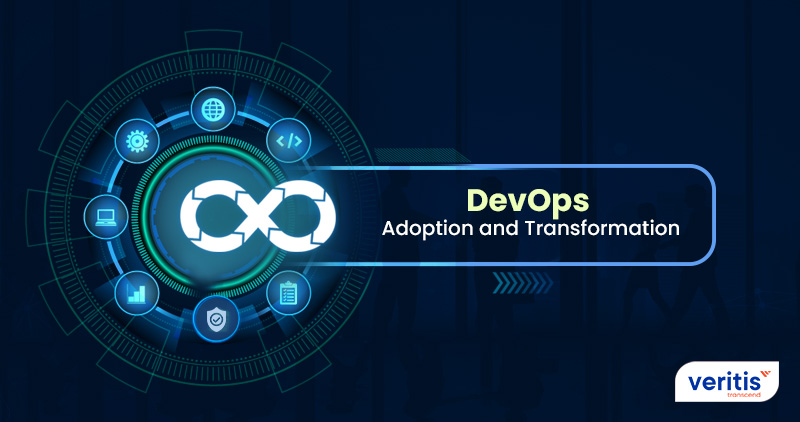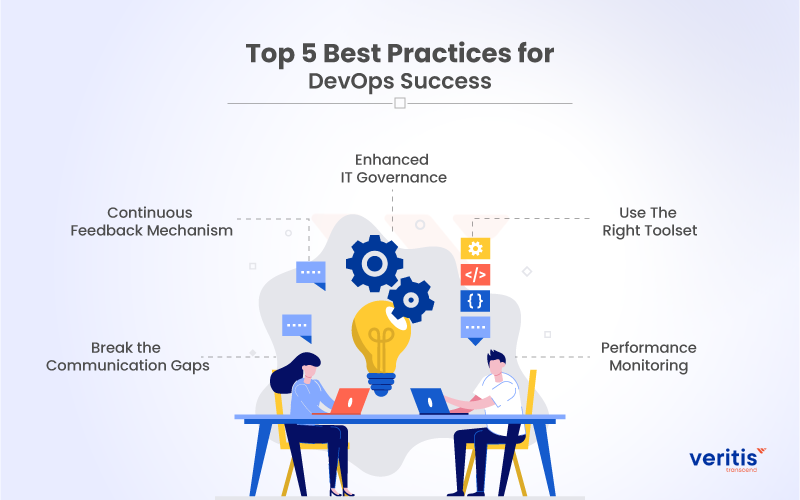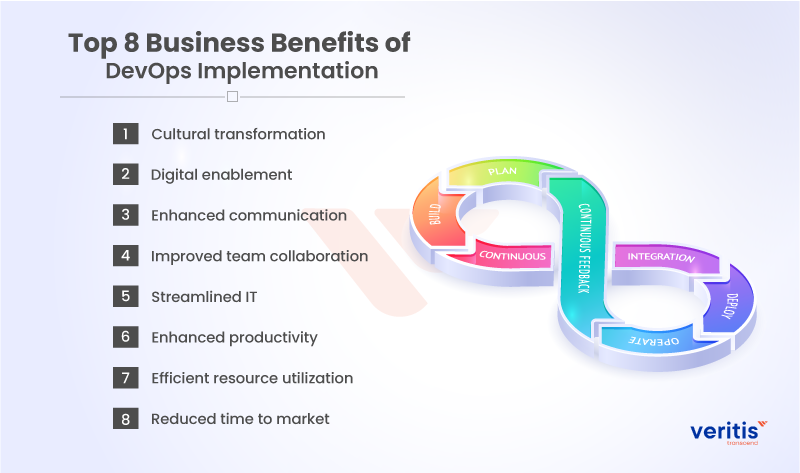
Since its inception, DevOps has enticed the world with its unique set of business benefits.
By seamlessly integrating Development and Operations teams, DevOps has paved way for faster software development and deployment, while promoting 100% customer satisfaction.
The DevOps culture has transformed the way IT functions, bringing teams together in achieving core business objectives.
While it has been a proven solution for many organizations, more firms still lack a proper understanding of core DevOps practices, and some largely misinterpret.
Understanding of its culture and core practices is vital to complete DevOps transformation, which makes a DevOps journey successful. Like any other process, DevOps transformation needs a step-wise approach to achieve desired results.
DevOps Transformation Strategy: A 6-Step Approach for DevOps Success

Step-1: Planning and Readiness
This is where you make the list of participants (possibly heads at all levels of hierarchy), existing processes, process design, and high-level thought processes. Alongside the technical teams like Dev, Ops and Security, core business teams should be the key stakeholders.
Leverage the excellence of involved stakeholders in designing the process and come to a common understanding. An experienced consultant or a subject-matter expert like Veritis is highly recommended to set things right and streamline.
Step-2: DevOps Center of Excellence (CoE)
You can’t do this just like that. Initially, you would need a DevOps Services Provider like Veritis and then the transition can happen in the next 12-24 months. A top-level enterprise head should lead this CoE with representatives from all delivery teams and vendor organizations being the members.
Step-3: Process Governance
This is where you streamline communication and execute process enablement, establishing a set of DevOps KPIs. In this step, you also set governing principles to establish DevOps culture among the teams. Set the roles and responsibilities of practitioners, share awareness about collaboration and empower teams.
Make sure the core KPIs are focused on business outcomes rather than individuals.
Step-4: Define In-Take Process
This step lays down a path to the teams in realizing the DevOps goals. Conduct workshops to your scrum teams with the help of subject matter experts. This step will guide the appropriate usage and right pick sizing of DevOps tools and resources. This lays down the path for further evolution and maturity.
Step-5: Identify and Run Pilot Programs
The time has come to test what you did. Identify the right applications and domains to apply the new DevOps practices. And, that focus area should have a portfolio required to be scaled to the enterprise level. This should be conducted with the level of details needed to run an end-to-end process that involves toolset, skilled personnel, manual and automated processes.
Get the subject matter experts, reusable assets, automation, security and necessary procedures. As the process heads further, compare the identified KPIs with the existing ones.
Step-6: Scale-Out DevOps Program
Gather feedback from pilot project metrics and scale them through multiple releases across different application portfolios. Your DevOps program is not complete without gathering feedbacks and making necessary optimizations. This is not a one-time process, and it should happen as a continuous chain.
These six steps are crucial to DevOps transformation and vary with each organization, depending on business nature, size, and objectives.
Useful Link: Continuous Integration: The DevOps Approach Which Fuels Productivity
If you are stepping ahead, then here are 5 best practices you need to know about DevOps transformation:
Top 5 Best Practices for DevOps Success

1) Break the Communication Gaps
This is the foremost aspect that a DevOps environment demands. Break the siloes among teams and pave the way for enhanced communication and collaboration aimed at core business objectives. You may do this through regular awareness programs on shared responsibilities, breaking large team into small groups, and usage of chat communications that can make discussions more interactive.
2) Continuous Feedback Mechanism
This is key to the user-centric software process, where the results are expected to be visible on time and as demand arises. Here is where the continuous feedback mechanism can help you contribute to continuous development, automation and testing. So, investment in any of these three areas may not give you desired results in the absence of a continuous feedback mechanism.
To implement this, create feedback loops that connect core development efforts with QA, OPs, users and markets.
Analyzing core DevOps metrics and KPIs through app monitoring and gathering insights from Big Data analytics and reporting tools are some ways to gain continuous feedback.
3) Enhanced IT Governance
Security risks are most obvious in the current IT scenario. Strong IT governance, backed by strict compliance and regulatory, is need of the hour. Make sure to have full visibility on access and knowledge in areas involving VMs. Post that, ensure to have compliance and regulatory in place across vulnerable areas to avoid potential risks.
Automation can help you achieve this goal. Transparency in the CI/CD process and strict monitoring of privilege access are some ways to accomplish this goal.
4) Use The Right Toolset
DevOps requires you to integrate different processes for seamless delivery and enhanced productivity. This needs the right selection of toolset. Some critical areas that require tools include collaboration and communication, API integration, reporting and capturing of manual and automated processes, and need for customization.
5) Performance Monitoring
Deployment time, failure rate and Mean Time To Repair (MTTR) are three key areas that require close monitoring to assess the overall DevOps performance and optimize performance. All these directly mean enhanced productivity and reduced time to market. This is crucial to achieving DevOps success.
Addressing recurring issues, automated tracking of core metrics and analysis of trends are some crucial aspects of achieving the goal of performance monitoring.
Useful Link: Measuring DevOps Success in 4 Ways!
Top 8 Business Benefits of DevOps Implementation

From a startup firm to any large enterprise, the effective implementation of DevOps transformation in a step-wise manner and following best practices, promises you:
1) Cultural transformation
2) Digital enablement
3) Enhanced communication
4) Improved team collaboration
5) Streamlined IT
6) Enhanced productivity
7) Efficient resource utilization
8) Reduced time to market
These practices lay down a successful path to DevOps. It all depends on your organizational readiness to change backed a well-defined strategy. – remove this sentence from conclusion and place it at the end of best practices section.
In Conclusion
Though DevOps adoption and implementation sound simple, doing DevOps at scale remains a challenging proposition for many organizations. One crucial aspect that many businesses misinterpret is that DevOps journey is merely technical. In contrast to the popular opinion, implementing DevOps right involves more than technology. Business must understand that DevOps journey covers processes and platforms, tools and technology, governance and metrics, people and culture, as well as management. This is where Veritis services proves worthy.
As an experienced IT Consulting Services Provider, Veritis offers DevOps Transformation Services to help you innovate and respond to an ever-changing technology landscape. Our IT experts have over a decade-long experience in guiding US businesses on their DevOps transformation journey. Whether you are a novice or a Fortune 500 company, we help you draft a comprehensive strategy that is critical to delivering sustainable business value through DevOps.
Key Takeaway
- Executing DevOps at scape remains a challenging proposition
- Many misinterpret that DevOps transformation is merely technical.
- DevOps covers processes and platforms, tools and technology, governance and metrics, people and culture, as well as management.
- Understanding DevOps culture and core practices is crucial for successful DevOps transformation.
Tags: Veritis blogs, devops transformation, devops culture, devops, devops practices, devops security, devops services provider, devops goals, devops experts, devops tools, devops processes, devops services company, devops solutions company, devops transformation challenges, devops benefits,
Additional Resources:

